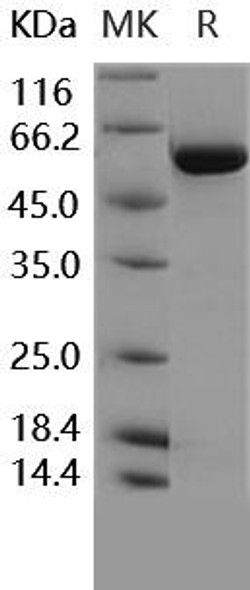Description
| Product Name: | Human TGFBR1/ALK-5 Recombinant Protein (His tag) |
| Product Code: | RPES5534 |
| Size: | 20µg |
| Species: | Human |
| Expression Host: | E.coli |
| Synonyms: | AAT5, ACVRLK4, ALK-5, ALK5, ESS1, LDS1, LDS1A, LDS2A, MSSE, SKR4, tbetaR-I, TGFR-1 |
| Mol Mass: | 10.12 kDa |
| AP Mol Mass: | 30 kDa |
| Tag: | N-His |
| Purity: | > 95 % as determined by reducing SDS-PAGE. |
| Endotoxin Level: | Please contact us for more information. |
| Bio Activity: | Testing in progress |
| Sequence: | Leu 34-Leu 126 |
| Accession: | P36897 |
| Storage: | Generally, lyophilized proteins are stable for up to 12 months when stored at -20 to -80°C. Reconstituted protein solution can be stored at 4-8°C for 2-7 days. Aliquots of reconstituted samples are stable at < -20°C for 3 months. |
| Shipping: | This product is provided as lyophilized powder which is shipped with ice packs. |
| Formulation: | Lyophilized from sterile PBS, pH 7.4. Normally 5 % - 8 % trehalose, mannitol and 0.01% Tween80 are added as protectants before lyophilization. Please refer to the specific buffer information in the printed manual. |
| Reconstitution: | Please refer to the printed manual for detailed information. |
| Background: | Transforming growth factor, beta receptor I, also known as Transforming growth factor-beta receptor type I , Serine / threonine-protein kinase receptor R4, Activin receptor-like kinase 5, SKR4, ALK-5, and TGFBR1, is a single-pass type I membrane protein which belongs to the protein kinase superfamily and TGFB receptor subfamily. TGFBR1 / ALK-5 is found in all tissues examined. It is most abundant in placenta and least abundant in brain and heart. TGF-beta functions as a tumor suppressor by inhibiting the cell cycle in the G1 phase. Administration of TGF-beta is able to protect against mammary tumor development in transgenic mouse models in vivo. Disruption of the TGF-beta/SMAD pathway has been implicated in a variety of human cancers, with the majority of colon and gastric cancers being caused by an inactivating mutation of TGF-beta RII. On ligand binding, TGFBR1 / ALK-5 forms a receptor complex consisting of two type I I and two type I transmembrane serine/threonine kinases. Type II receptors phosphorylate and activate type I receptors which auto-phosphorylate, then bind and activate SMAD transcriptional regulators. TGF-beta signaling via TGFBR1 / ALK-5 is not required in myocardial cells during mammalian cardiac development, but plays an irreplaceable cell-autonomous role regulating cellular communication, differentiation and proliferation in endocardial and epicardial cells. Defects in TGFBR1 / ALK-5 are the cause of Loeys-Dietz syndrome type 1A (LDS1A), Loeys-Dietz syndrome type 2A (LDS2A), and aortic aneurysm familial thoracic type 5 (AAT5). |






